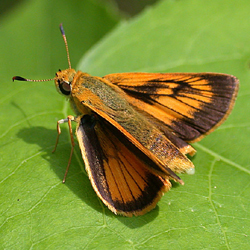Find a Butterfly
Delaware Skipper
Anatrytone logan
Named
Edwards, 1863

Identification
Perhaps the brightest of our colored skippers; the gleaming yellow-orange underwings are particularly striking in both sexes. Prominent black veining on golden wings above is also distinctive. The pattern of the forewing above with the cell outlined (narrowly in males, heavily in females) in black is unique in our fauna. Superficially similar to European Skipper, but longer overall and more brightly colored with wider dark borders to the wings above. Male European Skippers have a thin dash along the lower margin of the cell, but the cell never appears distinctly outlined.
Distribution
Central and Eastern North America from southeastern Alberta south across the Great Plains to El Salvador, east to southern New England and Florida. It reaches the northern limit of its New England range in southern Vermont and New Hampshire and southeastern Maine.
Status in Massachusetts
Apparently not recorded by Scudder. Fairly common to uncommon throughout most of the state. Apparently absent from most of Cape Cod and the islands at least until recently. First recorded on Martha‘s Vineyard in 1995 (Cassie). Seldom seen in numbers. Maximum: 57, Prescott (Hampshire Co.), 10 July 1994.

Flight Period in Massachusetts
Late June to early August, peaking in early July. Extreme Dates: 21 June 1988, Topsfield (Essex Co.), N. Beck; 1 August 1989, Hawley (Franklin Co.), S. Roble.
Larval Food Plants
Of the known food plants (all grasses), Little Bluestem (Schizachirium scoparium) and Switch Grass (Panicum virgatum) are the most likely hosts in Massachusetts, though it is also recorded from Big Bluestem (Andropogon gerardi). However it is not exclusively an "old field" species, and given the several other grassland habitats in which it is commonly found, other host species seem likely.
Adult Food sources
Visits a wide range of herbs and shrubs that flower at mid-summer. MBAP workers recorded it on 11 species including Pickerel Weed and Swamp Azalea as well as general favorites such as milkweeds, dogbanes, New Jersey Tea and Joe-Pye weeds. Heitzman and Heitzman (1987) note that it is one of the few butterflies in Missouri that will crawl into deep-throated flowers such as trumpet vine to nectar; according to Opler and Krizek (1984), its proboscis is proportionately longer than that of other skippers.

Habitat
Varied: dry fields, wetlands and woodland edges. Clark and Clark (1951) say that in Virginia the species occurs in "bogs and wet meadows in the high country (and)... in marshy areas and near wet woods on the Coastal Plain." In Massachusetts and elsewhere, it is also attracted to hayfields, weed lots, roadsides, suburban yards and other disturbed grassy habitats.
Life Cycle
EGG: Unknown?. LARVA: Quite distinctive when mature: pale blue-green covered with small black dots (tubercles) and black crescent-shaped stripes on the last two segments; head largely white with black bands; constructs a silk-lined leaf tube to which it retreats when not feeding. CHRYSALIS: Pale greenish with black on head and tail. OVERWINTERING STAGE: mature larva or pupa?
Account Author
Chris Leahy



